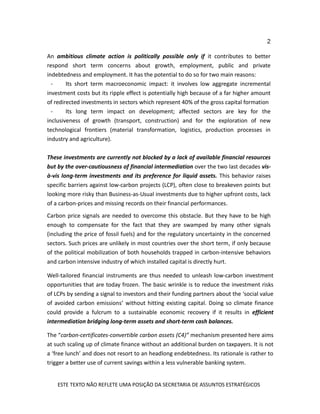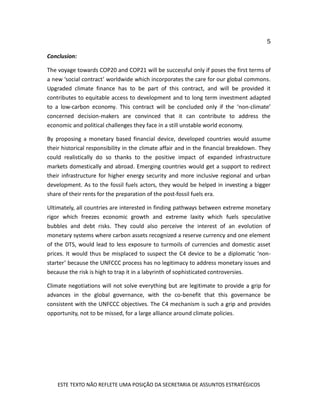Texto 1 executive-summary-concept-note- draft 2. doc
- 1. 1 ESTE TEXTO NÃO REFLETE UMA POSIÇÃO DA SECRETARIA DE ASSUNTOS ESTRATÉGICOS Low-carbon investment and sustainable growth A C4 mechanism: Carbon-asset Convertible Carbon Certificates Climate negotiations faced with a closing window of opportunity COP 20 at Lima and COP 21 at Paris will have to answer the call of the Cancun conference (COP-16) for “building a low-carbon society that … ensures continued high growth and … an ‘equitable access to sustainable development1 . This call shifts clearly the paradigm of climate negotiations away from adversarial game about sharing the remainder of a global emissions budget to a cooperative exercise linking climate and development policies in a diversity of domestic agendas. To achieve a ‘global peaking of GHG emissions” this exercise has to facilitate deep restructuration of existing capital stock in developed countries and massive redirection of infrastructure investments in developing countries to avoid their lock-in to carbon- intensive development pathways? The overall economic context is not conducive to ambitious public spending but action cannot wait for better public budgets and strong economic recovery in Annex 1 countries because the window of opportunity for stabilizing global warming under 2°C is rapidly closing. Short of a worldwide accepted sense of this urgency, this note presents a mechanism bringing a way-forward to continuing world development through massive low-carbon investments. Its rationale is that searching a least common denominator within the conventional negotiation tracks is a false realism which will fail to get maximum participation and will ultimately lead to inaction. Turning the constraints of an adverse context into a fulcrum for action 1 UNFCCC Decision 1/CP.16, para. 1.6, http://unfccc.int/resource/docs/2010/cop16/eng/07a01.pdf#page=2
- 2. 2 ESTE TEXTO NÃO REFLETE UMA POSIÇÃO DA SECRETARIA DE ASSUNTOS ESTRATÉGICOS An ambitious climate action is politically possible only if it contributes to better respond short term concerns about growth, employment, public and private indebtedness and employment. It has the potential to do so for two main reasons: - Its short term macroeconomic impact: it involves low aggregate incremental investment costs but its ripple effect is potentially high because of a far higher amount of redirected investments in sectors which represent 40% of the gross capital formation - Its long term impact on development; affected sectors are key for the inclusiveness of growth (transport, construction) and for the exploration of new technological frontiers (material transformation, logistics, production processes in industry and agriculture). These investments are currently not blocked by a lack of available financial resources but by the over-cautiousness of financial intermediation over the two last decades vis- à-vis long-term investments and its preference for liquid assets. This behavior raises specific barriers against low-carbon projects (LCP), often close to breakeven points but looking more risky than Business-as-Usual investments due to higher upfront costs, lack of a carbon-prices and missing records on their financial performances. Carbon price signals are needed to overcome this obstacle. But they have to be high enough to compensate for the fact that they are swamped by many other signals (including the price of fossil fuels) and for the regulatory uncertainty in the concerned sectors. Such prices are unlikely in most countries over the short term, if only because of the political mobilization of both households trapped in carbon-intensive behaviors and carbon intensive industry of which installed capital is directly hurt. Well-tailored financial instruments are thus needed to unleash low-carbon investment opportunities that are today frozen. The basic wrinkle is to reduce the investment risks of LCPs by sending a signal to investors and their funding partners about the ‘social value of avoided carbon emissions’ without hitting existing capital. Doing so climate finance could provide a fulcrum to a sustainable economic recovery if it results in efficient intermediation bridging long-term assets and short-term cash balances. The “carbon-certificates-convertible carbon assets (C4)” mechanism presented here aims at such scaling up of climate finance without an additional burden on taxpayers. It is not a ‘free lunch’ and does not resort to an headlong endebtedness. Its rationale is rather to trigger a better use of current savings within a less vulnerable banking system.
- 3. 3 ESTE TEXTO NÃO REFLETE UMA POSIÇÃO DA SECRETARIA DE ASSUNTOS ESTRATÉGICOS Rationale for a carbon-asset convertible carbon assets (C4) device Public credit is with taxation one of the few possible macroeconomic ‘lubricants’ to economic transitions at the level. Several monetary proposals have been suggested, including the use of Special Drawing Rights (SDR) issued by the IMF, and the implementation by central banks of ‘green quantitative easing policies’. Those proposals have the common goal to leverage private climate finance without direct public money disbursement. But in the absence of a carbon price, they don’t address the specific obstacles to the attractiveness of LCPs . The mechanism presented here (C4) is designed along the same lines but with a carbon- value mechanism improving the LCPs return on investment and reducing their risk by including a “social value of avoided carbon emissions (SVACE)”. Its basic principle consists in central banks injecting liquidities into the economy, in the same fashion as the “unconventional monetary policies” implemented after 2008, but under condition that the money is used to fund LCPs. A prerequisite is that governments provide a guarantee on a given amount of carbon assets. This will allow the central banks for opening credit lines, the reimbursement of the credits being made by carbon-certificates certifying the reduction of GHGs emissions, valued at the pre- determined SVACE and ultimately swapped into carbon assets. This targeted credit facility makes it possible for banks to expand credit to LCPs as it improves their profitability and offsets their extra risks relatively to conventional projects. Specialized investment funds, including the Green Climate fund, could also use this facility to back highly rated “AAA” climate bonds, in order to attract long-term saving. Institutional investors could be interested in safe ‘‘climate colored’’ bonds for both ethical and regulatory purposes. For the central banks, this device is equivalent to buying a carbon asset at a price which translates society’s willingness to pay for emissions reduction. For the macroeconomic policies it generates liquidity backed on ``actual wealth'' in the form of productive equipments and of averted carbon emissions, both certified by an independent body. It entails low inflationary risks given that both the volume and price of carbon certificates that the central bank is allowed to back will be bounded (ultimately to a few percent of the central bank balance sheet). From principles to climate negotiations
- 4. 4 ESTE TEXTO NÃO REFLETE UMA POSIÇÃO DA SECRETARIA DE ASSUNTOS ESTRATÉGICOS This type of mechanism could be included in the climate regime to be defined in Paris if: a) it relies on voluntary initiatives by a ‘club’ of countries, b) it is not seen as a full- fledged global architecture but as a support to a diversity of bottom-up initiatives and as a way of hedging against the economic and political costs of their fragmentation c) it incorporates no other penalty for a defaulter country than to be de facto excluded from the access to investments facilities provided by the system. To meet these conditions the C4 device necessitates an agreement of volunteer countries around a common set of principles agreed within the UNFCCC and periodically adapted: 1. A mutually agreed SVACE for the sake of overall consistency of decentralized initiatives: such agreement, for example within the corridor of values of carbon given by the IPCC to stick to the IPCC recommended trajectory can be easier to mutually agree than on a world carbon price, since a SVACE will not create immediate extra costs on firms and consumers. 2. Rules to determine the quantity of carbon assets issued by central banks (and guaranteed by their states) and the access rights of the recipient countries to the opened credit lines, so as to set a pullback force motivating countries to comply with their pledges and to gradually close the gap between these pledges and an emission trajectory converging to zero emission; 3. A credible MRV process under an Independent International Supervisory Body, in charge of determining the conformity of the projects to the NAMAS presented by the Parties, attributing carbon certificates to projects and certifying their completion. 4. A share of the carbon assets considered as a contribution to the Green Climate Fund (GCF). In addition to LCPs, this system could support any recognized “club” of actors in developing initiatives recognized by the UNFCCC. This could be the case for sectorial agreements in energy intensive industries and for initiatives taken by cities and local authorities to improve the synergies between climate policies and local development. Beyond, because this carbon-based monetary instrument embarks economic partners in a forward contract, this device would create a reference for carbon pricing mechanisms, progressively facilitating their social acceptance.
- 5. 5 ESTE TEXTO NÃO REFLETE UMA POSIÇÃO DA SECRETARIA DE ASSUNTOS ESTRATÉGICOS Conclusion: The voyage towards COP20 and COP21 will be successful only if poses the first terms of a new ‘social contract’ worldwide which incorporates the care for our global commons. Upgraded climate finance has to be part of this contract, and will be provided it contributes to equitable access to development and to long term investment adapted to a low-carbon economy. This contract will be concluded only if the ‘non-climate’ concerned decision-makers are convinced that it can contribute to address the economic and political challenges they face in a still unstable world economy. By proposing a monetary based financial device, developed countries would assume their historical responsibility in the climate affair and in the financial breakdown. They could realistically do so thanks to the positive impact of expanded infrastructure markets domestically and abroad. Emerging countries would get a support to redirect their infrastructure for higher energy security and more inclusive regional and urban development. As to the fossil fuels actors, they would be helped in investing a bigger share of their rents for the preparation of the post-fossil fuels era. Ultimately, all countries are interested in finding pathways between extreme monetary rigor which freezes economic growth and extreme laxity which fuels speculative bubbles and debt risks. They could also perceive the interest of an evolution of monetary systems where carbon assets recognized a reserve currency and one element of the DTS, would lead to less exposure to turmoils of currencies and domestic asset prices. It would thus be misplaced to suspect the C4 device to be a diplomatic ‘non- starter’ because the UNFCCC process has no legitimacy to address monetary issues and because the risk is high to trap it in a labyrinth of sophisticated controversies. Climate negotiations will not solve everything but are legitimate to provide a grip for advances in the global governance, with the co-benefit that this governance be consistent with the UNFCCC objectives. The C4 mechanism is such a grip and provides opportunity, not to be missed, for a large alliance around climate policies.





